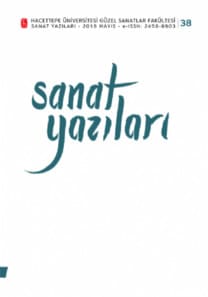LESTER D.LONGMAN PERSPEKTiFiNDEN, NEO-AVANGARD KONFORMiZM VE EĞLENCE
Peter Bürger'in Avangard Sanat Kuramı adlı kitabında 'Neo-Avangard' olarak tanımladığı ve İkinci Dünya Savaşı'ndan sonraki sanat akımlarına karşılık gelen süreçte sanat, tarihsel avangardın tersine Amerikalı eleştirmen ve düşünür Lester.D.Longman'a göre kaygı verici bir noktaya geldi. Longman gerek Art Forum dergisinde yazdığı yazılarda gerekse diğer kitaplarında bu süreci eleştirel yönden ele alan tartışmalı görüşler ortaya attı. Bugünkü çağdaş sanat ortamındaki eğilimleri, neo-avangard sürecin bir devamı olarak düşünürsek, İkinci Dünya Savaşı'ndan sonraki konformizm ve eğlence politikalarına Longman'ın tartışmalı görüşleri doğrultusunda yeniden bakmak gerekiyor. Longman'a göre çağımızda neo-avangard sanatı anlayabilir ve onun nedenlerini tanımlayabiliriz ancak bu hiç bir zaman bugünkü sanatı tümden kabul edeceğimiz anlamına da gelmemelidir. Longman konformist süreçte sanatların kendi eksantrik aşırılıkları ve modaya eklemlenmeleri yüzünden ölmekte olduğuna inanmakta, aydın elitlerin sadece inanç ve umuttan değil aynı zamanda cesaretten de yoksun olduğunu vurgulayarak, günümüzün çağdaş sanat ortamında bir çoğumuzun yakındığı bir konformizm ve eğlence durumunun geçmişini kültürel politikalar çerçevesinde ele almaktadır.
NEO-AVANT-GARDE CONFORMISM AND ENTERTAINMENT FROM THE PERSPECTIVE OF LESTER.D.LONGMAN
Following years of the World War Two, where innovative tendencies were described as 'Neo-Avant-garde' in the significant book entitled 'Avant-Garde Theory' by Peter Bürger, according to American theorist and critic Lester.D.Longman, art came to a very controversial point contrary to historical avant-garde practices. In his critial writings published both in Art Forum and other outstanding books, Longman has arguably spoken of these process. Considering today's art tendencies as subsequent practices to neo-avantgarde process it seems necessary to dwell upon again the issues of conformity in arts and entertainment in our current policies occurred after the World War Two within the perspective of Lester D.Longman's controversial opinions, for he negotiates the case of conformity and entertainment in contemporary art with respect to cultural policies. According to Longman although neo-avant garde art and its reasons can be wholly comprehended this does not mean that todays art should be excepted unconditionally. He believes that this conformist continuum of arts own eccentric extravaganza and its tendency to articulation to fashion are leading it to its own end. He continues, accusing the intellectual elite of lacking not only fate and hope but also courage, and investigates today's contemporary art scene, its past with respect to its conformist and entertainment milieu within the framework of cultural policies.
___
Bell, Daniel. (1974). The Coming of Post Industrial Society. London: HeinemannByrne, Rhona. "Huddle". Erişim: 15.09.2015, http://www.templebargallery.com/gallery/ exhibition/rhona-byrne
Bürger, Peter. (2003). Avangard Kuramı (E. Özbek, Çev.). İstanbul: İletişim Yayınları.
Connoly, Cyril. (1985). The Evening Colonnade. New York: A Harvest HBJ Book.
Cumming, Laura. Soundscape Reviews. The Guardian. Erişim: 12.07.2015. http://www.na- tionalgallery.org.uk/whats-on/soundscapes
Freeland, Cynthia. (2001). Sanat Kuramı (F. Demir, Çev.). Ankara: Dost Yayınları.
Gay, Peter. (2009). Modernism. London: Vintage Books.
Guilbaut, Serge. (2009). New York Modern Sanat Fikrini Nasıl Çaldı (E. Gökteke, Çev.). İstan- bul: Sel Yayınları.
Illich, Ivan. (1989). Şenlikli Toplum (A. Kot, Çev.). Ankara: Ayrıntı Yayınları.
Klein, Yves. (1974). 1928 - 1962, Selected Writings, (ed. J & J). London: The Tate Gallery.
Longman, Lester.D. (1962). Conformity in Arts. Art Forum, June, s. 30-80
Longman, Lester D. (1956). History and Appreciation of Art. Iowa City: University of Iowa.
Longman, Lester.D. (1986). Outline of Art History. Ann Arbor: University Microfilms.
Longman, Lester.D. (1950). 911 Questions on Art. Iowa City: University of Iowa.
Longman, Lester. D. (1947). Contemporary Painting. Journal of Aesthetics and Art Criticism , s. 85-110.
Longman, Lester.D. (1962). Cencorship. Art and Society, June 3, s. 57.
Mosse, George L. (1966). Nazi Culture: Intellectual, Cultural, and Social Life in the Third
Reich. New York: George L. Mosse Series. Özgür, Ferhat. (2013). John Cage Ve... Yapı Kredi Sanat Dünyamız, 132, s. 14
Sandler, Irving. (2004). A Sweeper-Up After Artists. London: Thames and Hudson.
Scheunemann, Dietrich. (2005). Avant-Garde / Neo-Avant-Garde (Avant-Garde Critical Stu- dies 17). New York-Amsterdam: Rodopi.
Shapiro, Karl. (1960). In Defense of Ignorance. London: Random House.
Trilling, Lionel. (1955). The Opposing Self. New York: Uniform Edition.
Toksöz, Emin. (2015). Çağdaş Sanat ve Eğlence Endüstrisi. (Yayımlanmamış Yüksek Lisans Tezi). Yeditepe Üniversitesi Sosyal Bilimler Enstitüsü, Sanat Yönetimi Anabilim Dalı.
Erişim: 14.09.2015, http://www.nationalgallery.org.uk/whats-on/soundscapes
Erişim: 01.08.2015, https://en.wikipedia.org/wiki/Iris_Clert_Gallery
- ISSN: 2458-8903
- Yayın Aralığı: Yılda 2 Sayı
- Başlangıç: 2001
- Yayıncı: -
Sayıdaki Diğer Makaleler
WITTGENSTEIN ÇEKİMİNDE SANAT VE DİL
SOSYO-KÜLTÜREL SÜRDÜRÜLEBİLİRLİK BAĞLAMINDA REHABİLİTE MÜZE YAPILARI
BİLGE SAYIL ONARAN, EMİNE NUR OZANÖZGÜ
DEĞİŞEN SERGİ MODELLERiNDEN BİR KESİT
ŞİŞKİN ANLATILARIN PANZEHİRİ: RİNEKE DİJKSTRA
ADİNKRA SEMBOLLERİNİN SERAMİK SANATINDA KULLANILMASI
NESRİN YEŞİLMEN, Cemalletin SEVİM
SUPERMAN ÇİZGİ ROMANLARINDA TARİH İÇERİSİNDE TASARIM UNSURLARININ DEĞİŞİMİ
POSTMODERN DÖNEMDE VENÜS'ÜN SANAT OBJESİ OLARAK KULLANIMI
GÖRSEL SANAT ALANINDA SANAT YAPITI- MİMARİ MEKÂN BİRLİKTELİĞİ ÜZERİNE
LESTER D.LONGMAN PERSPEKTiFiNDEN, NEO-AVANGARD KONFORMiZM VE EĞLENCE
